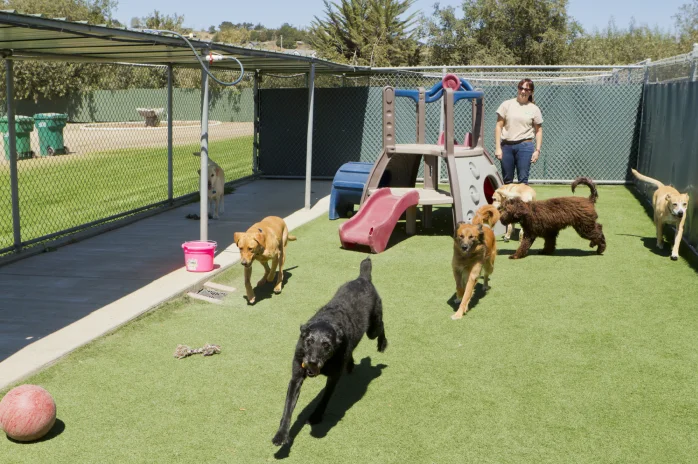The popularity of doggy daycares has been on the rise, and it’s easy to see why.
Nowadays, people view their dogs as cherished family members and want to provide them with the best care possible.
But let’s face it, life can get busy, and it’s not always easy to give our furry friends the attention and exercise they need.
That’s where doggy daycares come in.
They offer a convenient solution for pet owners who want their dogs to have socialization, playtime, and mental stimulation, even when they’re not around.
It’s like a fun and supervised playground for dogs!
Think about it—many of us have demanding jobs or commitments that keep us away from home for long hours.
Leaving our dogs alone all day can be tough on them. They get lonely, bored, and may even develop behavior problems.
Doggy daycares provide a safe and structured environment where dogs can spend their days having a blast with other furry pals.
They can play, run around, and receive attention and care from experienced staff members.
It’s a win-win situation for busy pet owners and their beloved canines!
According to experts, the doggy daycare industry was estimated to be worth around $1.1 billion in 2020 and growing steadily every year.
That’s a significant chunk of change!
And with the increasing number of pet owners seeking top-notch care and socialization options for their furry friends, the industry is only expected to grow. So, it’s safe to say that doggy daycares are here to stay, providing a much-needed service for dogs and their humans alike.
In this comprehensive guide, we’ll explore what to look for, what to avoid, red flags to watch out for, average prices, common concerns, and essential considerations to ensure a positive daycare experience for your dog.
Choosing the Right Doggy Daycare: What To Look For
Facility Evaluation
Cleanliness: Visit the daycare and observe if it is clean and well-maintained. A hygienic environment is essential to prevent the spread of diseases.
Safety Measures: Check for secure fencing, adequate supervision, and separate play areas for dogs of different sizes and temperaments.
Indoor and Outdoor Spaces: Ensure there are sufficient indoor and outdoor areas for dogs to exercise, play, and take potty breaks.
Staff Qualifications and Training
Experience: Inquire about the staff’s experience in handling and caring for dogs. Knowledge of dog behavior, first aid, and CPR training are valuable credentials.
Staff-to-Dog Ratio: A low staff-to-dog ratio ensures individual attention and supervision, promoting a safe and positive environment.
Enrichment and Activities

Playgroups: Ask how dogs are grouped together and if they consider temperament, size, and play style when organizing playgroups.
Enrichment Activities: Look for daycare facilities that offer mental stimulation, such as puzzle toys, interactive games, or supervised training sessions.
Health and Safety
Vaccination Requirements: Ensure that all dogs attending the daycare are up-to-date on vaccinations to minimize the risk of infectious diseases.
Emergency Procedures: Inquire about the facility’s protocols for handling emergencies and if they have a relationship with a nearby veterinary clinic.
Doggy Daycare Tour
Red Flags and Warning Signs
Lack of Transparency: If a daycare facility is hesitant to answer questions or provide information about their practices, it may indicate a lack of professionalism.
Overcrowding: An excessively crowded environment can lead to stress, aggression, and increased chances of accidents or injuries.
Inadequate Supervision: Insufficient staff or lack of supervision can pose risks and compromise the safety of the dogs.
Poor Communication: If the daycare fails to provide regular updates, feedback, or detailed reports on your dog’s activities and behavior, it may indicate a lack of professionalism and care.
Average Doggy Daycare Pricing
Doggy daycare prices can vary depending on factors such as location, facility amenities, staff qualifications, and services offered.
On average, expect to pay between $20 and $40 per day, with additional fees for additional services like grooming or specialized play sessions.
Common Concerns and Mitigation Strategies
Separation Anxiety: If your dog experiences separation anxiety, gradually introduce them to the daycare environment through short visits and positive reinforcement.
Socialization Challenges: Some dogs may struggle with socialization. Look for daycares that offer controlled introductions and separate play areas for shy or anxious dogs.
Health and Safety: Maintain regular vaccinations and flea/tick preventatives to protect your dog’s health. Inform the daycare of any specific medical conditions or allergies your dog may have.
Doggy daycare can provide a stimulating and social environment for your furry friend when you can’t be with them.
By carefully evaluating facilities, considering red flags, and addressing concerns, you can select a daycare that prioritizes the well-being and happiness of your dog.
Remember to maintain open communication with the daycare staff and monitor your dog’s behavior and overall satisfaction to ensure a positive and enriching experience for both you and your beloved canine companion.
























